 Tribal casinos reported nearly $30b in gaming revenue last year while posting their largest year-on-year revenue gain in a decade.
Tribal casinos reported nearly $30b in gaming revenue last year while posting their largest year-on-year revenue gain in a decade.
Figures released Tuesday by the National Indian Gaming Commission (NIGC) show tribal gaming revenue of $29.9b in 2015, up 5% from 2014’s numbers, which were up only 1.5% from 2013’s total. In 2006, total revenue was $24.9b.
Of the seven geographic regions into which the NIGC groups tribal gaming operators, the Sacramento region (California, Northern Nevada) posted the largest year-on-year gain at 8%. Oklahoma City (Western Oklahoma, Texas) ranked second with 6.7%, while Tulsa (Kansas, Eastern Oklahoma) placed third with 6.5%. All seven regions posted growth last year compared to five year-on-year gainers in 2014.
Sacramento’s 71 operations held on to their grip atop the geographic revenue chart with $7.9b, up from $7.4b in 2014. The 31 operations in the Washington, DC region – which runs along the east coast from Connecticut to Louisiana and as far inland as Missouri – ranked second with $7b, a gain of $200m from 2014, while the 134 operations in St. Paul (from Michigan to Wyoming) gained $100m to $4.8b.
Of the 474 tribal gaming operations tracked by the NIGC, only 31 reported gross gaming revenue of $250m or greater, but these 31 operators accounted for 45% of the overall pie. More than half (57%) of tribal gaming operations generated less than $25m per year while 20% generated under $3m per year.
NIGC chairman Jonodev O. Chaudhuri said “the strong regulation that tribes as well as federal regulators and other stakeholders provides has played a key role in the stability and growth of the Indian gaming industry by providing consistency and predictability.”
Chaudhuri took pains to point out that tribal gaming was “fundamentally different” from commercial casinos, in that it provided financial benefits – not to mention slimmer children – to Indian peoples that have yet to be matched by any other economic driver.